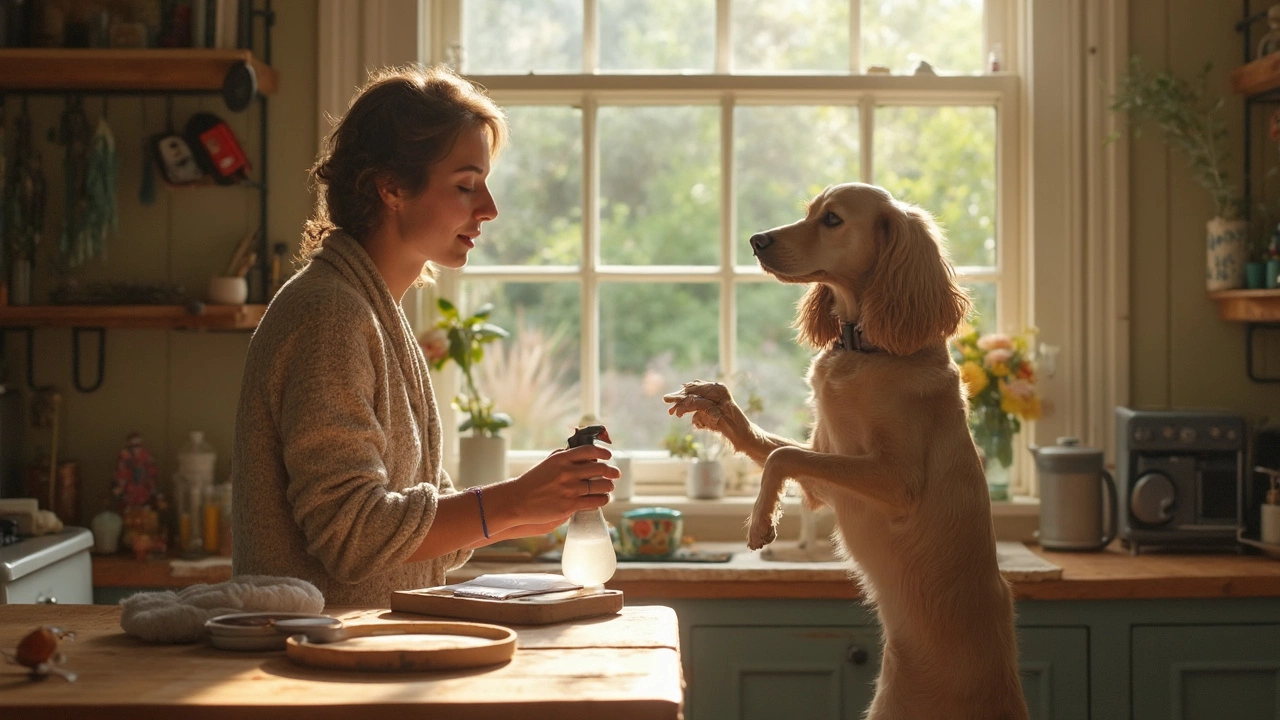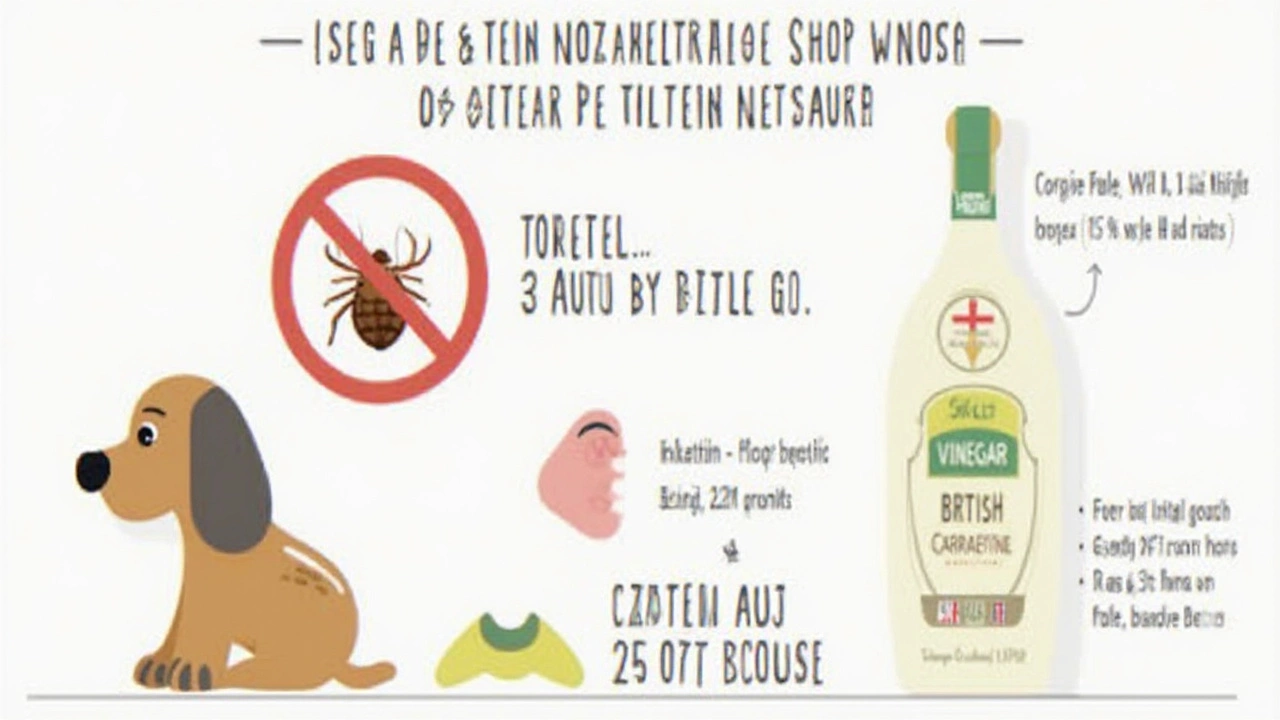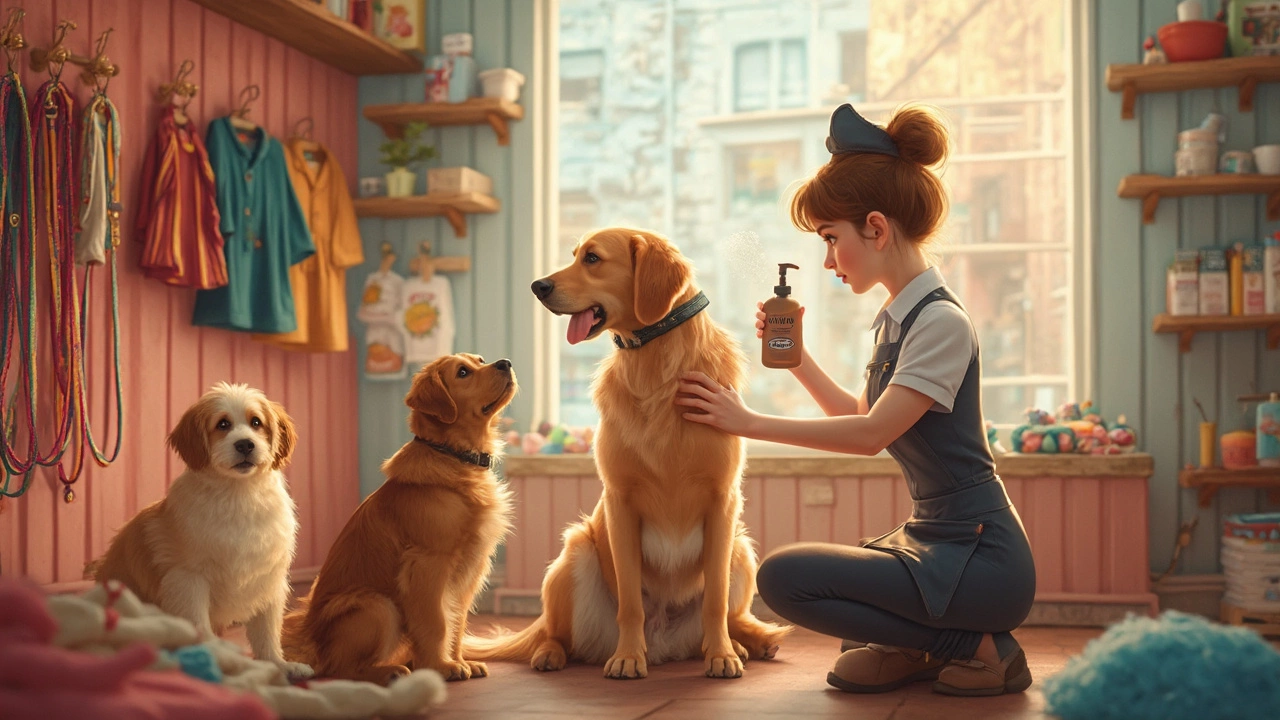Ever handed over your dog to be groomed, only to wonder why the air smells a little bit like a salad? Yep, it’s the vinegar. Some groomers actually use diluted vinegar sprays—on purpose. But before your mind jumps to vinegar baths or oddball fads, let’s get real about what’s actually happening.
Vinegar isn’t just for cleaning kitchens or making pickles. In the grooming world, it’s a simple tool that knocks out odors, keeps some pests away, and helps make coats shiny. It’s way less mysterious than it sounds. Most groomers use good old white distilled vinegar, mixed with water, so it’s not all harsh or overpowering. This blend can help neutralize that ‘wet dog’ smell that hangs around after a bath, especially if a dog’s got extra oily fur or rolled in something questionable on their last walk.
Plus, it’s safe when used right. We’re not talking about dousing your pup straight from the bottle—mixing vinegar with water (usually about one part vinegar, three parts water) does the trick. You just spritz it on, avoid the eyes, and let it dry. That’s really all there is to it.
- What Vinegar Does in Dog Grooming
- Why Not Just Use Shampoo?
- The Safety of Vinegar for Dogs
- Extra Benefits: Odor, Fleas, and More
- DIY Tips: Using Vinegar Safely at Home
What Vinegar Does in Dog Grooming
Groomers love vinegar because it’s cheap, super easy to find, and really gets the job done when it comes to cleaning up dogs. The main reason? Vinegar spray helps cut through the grime and build-up that regular bathing sometimes leaves behind—think mystery dirt, sticky residue, or even leftover product from previous grooming sessions. Vinegar’s natural acidity breaks all that down without being harsh, especially when you dilute it with water.
Not a fan of that strong dog odor after your pup rolls in something odd? Vinegar neutralizes nasty smells instead of just covering them up. It actually reacts with odor-causing particles and helps remove them rather than masking with heavy scents. That’s why your dog leaves the groomer smelling just clean—not perfumed or artificial.
Another plus: vinegar acts as a mild disinfectant. It can kill off certain bacteria and fungi living in your dog’s fur or on their skin. This makes it perfect for dogs that spend lots of time outdoors or tend to get yeasty or a little greasy sometimes. Here's a quick look at what vinegar can target:
- Neutralizing ‘wet dog’ and other stubborn smells
- Breaking down grease and dirt in the coat
- Mild help against bacteria or yeast growth
- Refreshing and softening the fur for a nice shine
It isn’t a miracle cure-all, but when paired with regular dog grooming, vinegar gives that final boost in cleanliness—especially for dogs with oily skin or those prone to mild skin issues. A few quick sprays and your dog is fresher, drier, and less likely to get that musty, dirty-dog smell back too soon.
Why Not Just Use Shampoo?
You’d think dog grooming would be as simple as a good scrub with regular shampoo. But here’s the truth: even the best shampoos leave behind stuff that normal noses can’t catch but dogs (and groomers) can definitely notice.
Dog shampoos are made to clean and sometimes deodorize, but they’re not always great at tackling that deep, stubborn funk. Think about times your dog got skunked, rolled in something nasty at the park, or just has that funky smell no matter how many baths they get. Shampoos can mask it, but vinegar actually neutralizes it.
Another thing—some dogs have skin that just doesn’t get along with heavy fragrances or strong chemicals found in certain shampoos. Using a gentle vinegar spray after a wash gives the coat a nice clean feel without loading it up with more scent or causing extra irritation.
Here’s a quick look at what vinegar brings to the table compared to shampoo:
| Method | Main Purpose | Effectiveness on Odor | Harsh on Skin? |
|---|---|---|---|
| Standard Shampoo | Cleans fur & skin | Decent—often masks smells | Can be, for sensitive dogs |
| Vinegar Spray | Neutralizes smells, shines coat | High—breaks down odors | Gentle if diluted |
On top of all that, vinegar is cheap, easy to find, and doesn’t leave any soapy residue, which helps make the coat smoother and sometimes less prone to matting. It’s not a replacement for a bath but a helpful sidekick that fills in where shampoo just can’t cut it.
That’s why plenty of pros keep a bottle of vinegar spray handy—even after a sudsy session with the fanciest shampoos on the shelf.

The Safety of Vinegar for Dogs
If you’re nervous about using vinegar spray on your pup, you’re not alone. Lots of dog owners wonder if this kitchen staple can really be safe for their pets. Here’s the real deal: white distilled vinegar and apple cider vinegar are both considered safe for dogs if you use them the right way.
First up, dilution is key. Groomers never use full-strength vinegar—doing so could sting, dry out your dog’s skin, or just turn playtime into a sneeze-fest. The typical mix is 1 part vinegar to 3 parts water. This combo helps with deodorizing and even calms mild itchiness without being harsh.
Don’t spray the face or eyes. Even diluted, vinegar will burn if it gets in your dog’s eyes, nose, or mouth. Most groomers cover the dog’s head or spray a rag and wipe only the coat and body. Sensitive spots like open wounds, skin sores, or active rashes? Skip them completely—vinegar can make them worse.
A few dogs have super-sensitive skin or allergies, so it’s smart to test a small patch before going all-in, especially with a new pet care routine. Watch that area for a few hours. No redness, swelling, or itching? You’re good to go.
Check the numbers—there’s real research backing this up. The American Kennel Club points out that properly diluted vinegar spray is a safe, chemical-free way to cut dog odor. A 2022 survey from a pet care clinic found that about 1 in 4 groomers use vinegar to manage coat health and odor because it gets results and dodges heavy chemicals.
- Always dilute vinegar before use
- Avoid eyes, nose, mouth, and broken skin
- Test a small patch before spraying all over
- Use sparingly with dogs who have known skin allergies
With these tips, you can add vinegar to your dog grooming routine without worry—just stick to the basics, don’t overdo it, and watch how your dog reacts.
Extra Benefits: Odor, Fleas, and More
The real magic behind vinegar in dog grooming starts with odor control. Dogs have a knack for picking up all sorts of unpleasant smells. When groomers spray dogs with a mix of vinegar and water, it actually neutralizes the bacteria responsible for the worst odors. This trick isn’t about just covering up smells—it’s about stopping them at the source.
Here’s the fun part: vinegar doesn’t stop at stinky odors. It also makes life tough for fleas and some other pests. While vinegar won’t treat a serious flea infestation, groomers use it on freshly bathed dogs to act as a mild deterrent. Fleas hate the acidic environment vinegar creates on the fur, so they’re less likely to stick around. “Vinegar won’t cure all flea problems,” says the American Kennel Club, “but it can be part of a smart prevention routine when paired with other vet-approved methods.”
"Vinegar is a safe and natural deodorizer for pets, and it’s been used for generations to help reduce odors and manage minor skin problems." —American Kennel Club
Another perk? Vinegar can help clear up minor skin itches and balance your dog’s coat. Sometimes, dogs get a bit itchy from pollen, dust, or leftover shampoo. Vinegar’s acidity helps balance the pH level on the skin, making things less itchy and helping with minor flare-ups. Plus, because vinegar cuts through oil, it leaves fur looking clean and less greasy.
| Benefit | How Vinegar Helps |
|---|---|
| Odor Control | Neutralizes bacteria, especially after baths |
| Flea Deterrent | Creates a mildly acidic coat fleas dislike |
| Skin Relief | Balances pH and calms minor itching |
| Shiny Coat | Removes excess oil build-up |
Bottom line: a simple vinegar spray is one of those cheap and effective pet care hacks that covers more than you’d expect. Just remember, it’s not a replacement for real flea treatments or medical care, but as part of the routine, it’s hard to beat for usefulness and peace of mind.

DIY Tips: Using Vinegar Safely at Home
If you’re up for giving the vinegar spray trick a go in your own grooming routine, you’ll want to make sure it’s safe and not stressful for your pup. Here’s what you need to know before grabbing the spray bottle.
First, always use white distilled vinegar. Skip apple cider vinegar unless your vet gave you the nod; white vinegar is neutral, cheaper, and doesn’t carry a strong scent once dry. The basic recipe is super simple:
- Mix 1 part white vinegar with 3 parts cool water (for example, 1/4 cup vinegar to 3/4 cup water).
- Pour it into a clean spray bottle (rinse well if it’s not new—leftover cleaning products are a no-go).
- Shake gently before each use.
Here are a few need-to-knows:
- Always do a patch test on your dog’s back or hip. Wait a few hours—if there’s no redness or irritation, you’re good.
- Stay clear of the eyes and inside ears. Vinegar burns if it gets in those spots.
- Lightly mist onto your dog’s coat, not the skin. Brush through for even coverage.
- Don’t use on open wounds or irritated spots. Skip the spray if your dog’s just had a scratch or skin problem.
- Use only once a week to avoid drying out your pup’s skin.
Why bother? That vinegar spray works wonders for dissolving stinky oils, plus it can help get rid of leftover soap just like a final rinse at the salon. Plenty of groomers have reported seeing less scratching and fewer lingering “dirty dog” odors when dogs get a vinegar spritz after their bath.
Check out this rundown comparing regular dog shampoo and vinegar spray:
| Dog Shampoo | Vinegar Spray | |
|---|---|---|
| Removes Dirt | Yes | Partially |
| Kills Odors | Temporarily | Very Effective |
| Detangles Fur | Some | Helps |
| Safe for Weekly Use | Usually | Yes (if diluted) |
| Helps Repel Fleas | Rarely | Sometimes |
Just remember: if your dog’s got super sensitive skin or allergies, it’s smart to check with your vet before you start any new grooming routine (including this one). And always stick to the right ratio—that’s the real secret to keeping it gentle.

